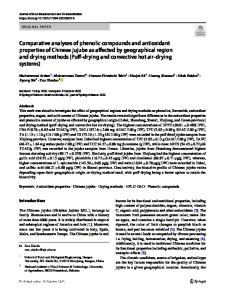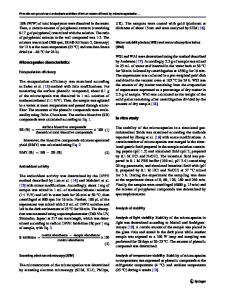Effect of Ultrasound on In Vitro Bioaccessibility of Phenolic Compounds and Antioxidant Capacity of Blackberry ( Rubus f
- PDF / 263,133 Bytes
- 6 Pages / 595.276 x 790.866 pts Page_size
- 73 Downloads / 373 Views
ORIGINAL PAPER
Effect of Ultrasound on In Vitro Bioaccessibility of Phenolic Compounds and Antioxidant Capacity of Blackberry (Rubus fruticosus) Residues cv. Tupy Quinatzin Yadira Zafra-Rojas 1 & Blanca Edelia González-Martínez 2 & Nelly del Socorro Cruz-Cansino 1 & Manuel López-Cabanillas 2 & Ángela Suárez-Jacobo 3 & Alicia Cervantes-Elizarrarás 1 & Esther Ramírez-Moreno 1 Accepted: 15 September 2020 # Springer Science+Business Media, LLC, part of Springer Nature 2020
Abstract Agro-industries residues of fruit are a source of antioxidant compounds with a possible health impact. The aim of this study was to evaluate the total phenolic content (TPC), total monomeric anthocyanins (TMA), individual phenolic compounds (IPC), antioxidant capacity and in vitro intestinal bioaccessibility from blackberry residues (BR), and ultrasonicated blackberry residues (US-BR). The results showed that BR had higher TPC (4,016.43 mg GAE/100 g DM), TMA (364.53 mg Cy-3-Gl/100 g) antioxidant capacity by ABTS (5,422.38 mg AAE/100 g DM) and FRAP (12511.44 μmol Fe(II)/100 g DM) than US-BR. TPC and TMA obtained by US-BR were more bioaccessible (70 and 51%, respectively) compared to BR (37 and 34%, respectively). The use of ultrasound can aid the extraction of total phenolic compounds and improve their bioaccessibility. After acid hydrolysis, a high amount of individual phenolic compounds (IPC) in US-BR (chlorogenic acid, caffeic acid, apigenin, luteolin and kaempferol) was obtained compared with BR. Before in vitro digestion, total individual compounds (TIC) content was lower in the BR (29.49 mg/100 g DM) than US-BR (92.36 mg/100 g DM) and there was 5 and < 1%, respectively. Therefore, the food industry would use residues of blackberry fruits as a source of antioxidant compounds with possible health benefits. Keywords Fruit by-products . Blackberry pomace . Dialyzed fraction . Anthocyanins . Phenolic acids
Introduction Blackberry fruit comes from the Rosaceae family and genus Rubus, their colorations are reddish to purple depending on the state of maturation [1, 2]. Blackberry is harvested in Asia, Electronic supplementary material The online version of this article (https://doi.org/10.1007/s11130-020-00855-7) contains supplementary material, which is available to authorized users. * Esther Ramírez-Moreno [email protected] 1
Universidad Autónoma del Estado de Hidalgo, Instituto de Ciencias de la Salud, Área Académica de Nutrición, Centro de Investigación Interdisciplinario, Circuito Actopan-Tilcuautla s/n. Ex-hacienda La Concepción, 42160 San Agustín Tlaxiaca, Hidalgo, México
2
Universidad Autónoma de Nuevo León, Facultad de Salud Pública y Nutrición, Centro de Investigación en Nutrición y Salud Pública, Monterrey, Nuevo León, México
3
Centro de Investigación y Asistencia en Tecnología y Diseño del Estado de Jalisco, A.C. Subsede Noreste, Parque PIIT, Vía de Innovación 404, 66629 Apodaca, Nuevo León, México
Africa, Europe and America, the majority cultivars in Mexico are Brazos and Tupy [3]. Blackberry (Rubus fruticosus) fruit is ch
Data Loading...











